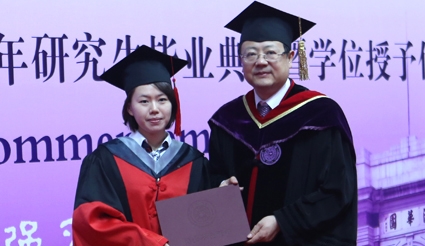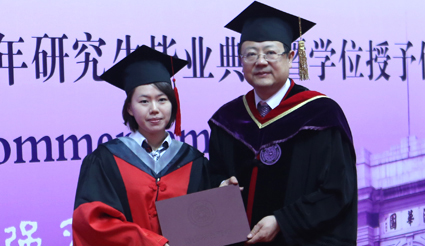
当前课程知识点:学术英语 > Module1 Academic Listening > Extended reading > html
Reading 1
What Do You Think the Internet Will Be Like in 2050?
Jonathan Strickland
1 As technologies go, the Internet is still a baby. You can trace its roots back to the 1950s, when computer technology itself was quite young. In the 1960s and ’70s, teams of engineers and computer scientists worked to build the foundation for a network of networks. ARPANET, one of the Internet’s predecessors, began modestly as a three-node network. Gradually, smart people began to link networks together using protocols from the ARPANET project. In the 1980s, this network proved to be a valuable tool for research and communication. A decade later, the general public became aware of the Internet as tools like the World Wide Web made it easy for the general user to access it.
2 But what’s in the future for the Internet? The last few years have pointed toward mobile computing. Wireless computer networks and high-speed cellular communication make it easy to connect to the Internet. Some devices remain perpetually connected unless you turn them off or set them to airplane mode. I think these trends point to what the Internet will be in 2050 — pervasive.
3 The evolution of the Internet and the evolution of mobile computing will be one and the same. We’ll start to see Internet capability in more devices and products. Networking coverage will increase. Wireless networks will act as the primary access point for most devices. The machines acting as the backbone for the Internet will rely upon high-speed physical connections capable of transmitting data at a blistering speed. Sending the equivalent of a Blu-ray disc full of data across a network in the blink of an eye will be the norm.
4 In this world, we’ll experience a reality forged from the physical world around us and the digital world we create to exist on top of it. We’ll be able to view this world dozens of different ways. By 2050, it’s not unreasonable to guess that we could have eye implants allowing us to see the digital world without the need for a display. Even if we decide that altering ourselves is ethically questionable, we can achieve a similar effect just by building display capabilities into a pair of glasses.
5 Imagine looking around you and activating a digital overlay that gives you volumes of information about your surroundings. You could use this capability to perform routine tasks such as finding a place to grab a bite to eat or look up a landlord’s contact information. But that’s just the beginning! What if you could swap out the view so that you could see what your surroundings looked like centuries ago? Imagine touring a city like Rome and with a simple command viewing it as if you were present when Julius Caesar became emperor. A pervasive Internet coupled with the right mobile technology could make it happen.
6 It’s possible that in this future, privacy becomes obsolete. As we move to a mobile, social and pervasive Internet, we may see our private information become part of the public record. What if you could use that same pair of glasses and Internet connection to look up information about someone standing near you? Imagine meeting someone you’d like to date. You decide to see what this person is like, so you execute a quick command to take a look at what the Internet has to say about him or her. Through facial recognition software and a connection to the Internet, you have instant access to public information about your interest, including any social networks he or she might belong to. It all appears in a cloud around the person and soon you know his or her interests, opinions and even relationship status. But don’t feel creepy for doing it — other people are doing the same thing to you at the same time.
7 Could this be the real future of the Internet? Science fiction authors have warned us about governments or corporations taking a great interest in our private information for wicked purposes. But perhaps in the end Big Brother[1] will turn out to be you and me. What’s your opinion? Do you see the Internet becoming part of our perception of the real world around us or do you believe the two will forever remain separate concepts?
(743 words)
(Adapted from http://computer.howstuffworks.com/internet-in-2050.htm)
[1] Big Brother: a fictional character and symbol in George Orwell’s novel Nineteen Eighty-Four (published in 1949). In modern culture the term refers to a person, government, or organization which has complete control over people and is always checking what they do.
-Welcome to EAP course 欢迎学习“学术英语课程”
-Extended reading Unit 1
--html
--html
-Extended reading exercises
-1.1 Introduction to the module of listening skills 模块介绍
-1.2 Predicting the content 预测听力内容
--Video
--html
--图片全屏
--Audio
--html
--图片全屏
--html
--外部链接
-Module1 Listening--1.2
-1.3 Understanding main ideas: key words 抓住关键词理解大意
--Video
--html
--Video
--外部链接
-Module1 Listening--1.3
-1.4 Understanding supporting evidence (I): explicit means 理解支持性证据 (I):显性证据
--Video
--html
--图片全屏
--Audio
--外部链接
-Module1 Listening--1.4
-1.5 Understanding supporting evidence (II): implicit means 理解支持性证据 (II):隐性证据
--Video
--html
--Video
-Module1 Listening--1.5
-1.6 Recognizing rhetorical questions 辨别修辞问句
--Video
--html
--Video
-Module1 Listening——1.6
-1.7 Understanding the organization of a lecture (I): chronological order 理解讲座结构 (I):时间顺序
--Video
--html
--Video
-Module1 Listening--1.7
-1.8 Understanding the organization of a lecture (II): categorization 理解讲座结构 (II):归类
--Video
--html
--Video
-Module1 Listening--1.8
-1.9 Handling unfamiliar words 应对不熟悉词汇
--Video
--html
--Video
--html
-Module1 Listening--1.9
-1.10 Understanding vocabulary from the context 从上下文理解词汇
--Video
--html
--Video
--html
-Module1 Listening--1.10
-1.11 Focusing on numbers & statistics 注意数字与数据
--Video
--html
--Video
-Module1 Listening--1.11
-1.12 Recognizing analogy 辨别类比
--Video
--html
--Video
-Module1 Listening--1.12
-1.13 Recognizing signposting language (I): contrast 辨别指示性语言 (I):对比
--Video
--html
--Video
-Module1 Listening--1.13
-1.14 Recognizing signposting language (II): consequence 辨别指示性语言 (II):结果
--Video
--html
--Video
-Module1 Listening--1.14
-1.15 Recognizing signposting language (III): presenting factual information 辨别指示性语言 (III):陈述事实信息
--Video
--html
--Video
-Module1 Listening--1.15
-1.16 Note-taking: numbers & diagrams 记笔记:数字和图表
--Video
--html
--Video
--html
--Video
-Module1 Listening--1.16
-1.17 Summary to the module of listening skills 模块总结
--Video
-Module test
--Video
--html
--Module1 Academic Listening--Module test
-Extended reading
--html
--html
-Module1 Extended reading
-2.1 Introduction to the module of reading skills 模块介绍
--Video
-Module2 Reading--2.1
-2.2 Surveying an article 浏览文章
--Video
-Module2 Reading--2.2
-2.3 Skimming and scanning 查读和略读
--Video
-Module2 Reading--2.3
-2.4 Recognizing text organization / structure 识别文章结构
--Video
-Module2 Reading--2.4
-2.5 Identifying the author's evaluation 识别作者评价
--Video
-Module2 Reading--2.5
-2.6 Identifying the thesis statement 识别文章中心句
--Video
-Module2 Reading--2.6
-2.7 Increasing reading speed 提高阅读速度
--Video
-Module2 Reading--2.7
-Module test 2-1
--html
--外部链接
--html
--html
--图片全屏
--html
--html
--外部链接
-Module2 Academic Reading--Module test 2-1
-2.8 Guessing unfamiliar words from context 从上下文猜测词意
--Video
-Module2 Reading--2.8
-2.9 Recognizing topic sentence and supporting evidence 识别主题句和支持性证据
--Video
-Module2 Reading--2.9
-2.10 Understanding quotations 理解引语
--Video
-Module2 Reading--2.10
-2.11 Using questions for effective reading 使用问句促进阅读
--Video
-Module2 Reading--2.11
-2.12 Recognizing classification 识别分类
--Video
-Module2 Reading--2.12
-2.13 Recognizing comparison and contrast 识别比较和对比
--Video
-Module2 Reading--2.13
-2.14 Recognizing cause and effect 识别因果关系
--Video
-Module2 Reading--2.14
-2.15 Annotating the text 标记文章
--Video
-Module2 Reading--2.15
-2.16 Summary to the module of reading skills 模块总结
--Video
-Module test 2-2
--html
--外部链接
--html
--外部链接
--html
--外部链接
--Module2 Academic Reading--Module test 2-2
-Extended reading
--html
--html
-Module2 Extended reading
-3.1 Introduction to the module of speaking skills 模块介绍
--Video
--html
-Module3 Speaking--3.1
-3.2 Preparing for a presentation 准备陈述报告
--Video
-Module3 Speaking--3.2
-3.3 Opening a presentation 开始陈述报告
--Video
-Module3 Speaking--3.3
-3.4 Presenting the main body 陈述报告主体
--Video
-Module3 Speaking--3.4
-3.5 Concluding the presentation 结束陈述报告
--Video
-Module3 Speaking--3.5
-3.6 Evaluating students' presentation 评价学生的陈述报告
--Video
-Module3 Speaking--3.6
-Module test 3-1
--html
-Module3 Academic Speaking--Module test 3-1
-3.7 Opening a discussion; Agreeing and disagreeing 开始讨论;表达赞同与不赞同
--Video
-Module3 Speaking--3.7
-3.8 Keeping a discussion going; Discussing the pros and cons 保持讨论;支持与反对
--Video
-Module3 Speaking--3.8
-3.9 Interrupting politely; Asking for clarification or confirmation 客气地打断讨论;要求对方阐释或确认
--Video
-Module3 Speaking--3.9
-3.10 Expressing an opinion; Supporting an opinion 表达观点;支撑观点
--Video
--Video
-Module3 Speaking--3.10
-3.11 Evaluating students' group discussion 评价学生的讨论
--Video
-Module3 Speaking--3.11
-3.12 Summary to the module of speaking skills 模块总结
--Video
-Module3 Speaking--3.12
-Module test 3-2
--Module3 Academic Speaking--Module test 3-2
-Extended reading
--html
--html
--Module3 Extended reading
-4.1 Introduction to the module of writing skills 模块介绍
--Video
-Module4 Writing--4.1
-4.2 Writing an introduction 写文章开头
--Video
-Module4 Writing--4.2
-4.3 Writing a thesis statement 写文章中心句
--Video
-Module4 Writing--4.3
-4.4 Writing the main body 写文章主体
--Video
-Module4 Writing--4.4
-4.5 Writing a body paragraph 写主体段落
--Video
-Module4 Writing--4.5
-4.6 Writing a conclusion 写文章结论
--Video
-Module4 Writing--4.6
-4.7 Evaluating students' writing (structure) 评价学生的写作(结构方面)
--Video
-Module4 Writing--4.7
-Module test 2-1
--Module4 Academic Writing--Module test 2-1
-4.8 Writing in formal languge 用正式文体写作
--Video
--Video
-Module4 Writing--4.8
-4.9 Writing in cautious language 用谨慎的话语写作
--Video
--Video
-Module4 Writing--4.9
-4.10 Writing in efficient language 用简练的话语写作
--Video
--Video
-Module4 Writing--4.10
-4.11 Avoiding plagiarism (quoting, paraphrasing and summarizing) 避免学术抄袭(引用,改写,总结)
--Video
-Module4 Writing--4.11
-4.12 Avoiding plagiarism (acknowledging sources) 避免学术抄袭(注明出处)
--Video
-Module4 Writing--4.12
-4.13 Summary to the module of writing skills
--Video
-Module4 Writing--4.13
-Module test 2-2
--Module4 Academic Writing--Module test 2-2
-Extended reading
--html
--html
--Module4 Extended readinging
-5.1 Introduction to the module of translating skills
--Video
-Module5 Translating--5.1
-5.2 What is translation 什么是翻译
--Video
-5.3 How to get ready for translation? 怎样做好翻译的准备?
--Video
-Module5 Translating--5.3
-5.4 Word-for-word translation 逐字翻译
--Video
-Module5 Translating--5.4
-5.5 Diction (I): grammatical clues 词意的选择(I):语法线索
--Video
-Module5 Translating--5.5
-5.6 Diction (II): collocation clues 词意的选择(I):词汇搭配线索
--Video
-Module5 Translating--5.6
-5.7 Omission (I): leaving out unnecessary prepositions and conjunctions 省略法(I):删减不必要的介词和连词
--Video
-Module5 Academic Translating--5.7 Omissio
-5.8 Omission (II): leaving out unnecessary articles 省略法(II):删减不必要的冠词
--Video
-Module5 Translating--5.8
-5.9 Conversion (I): translating nouns as adjectives or verbs 词性转换(I):名词翻为形容词或动词
--Video
-Module5 Translating--5.9
-5.10 Conversion (II): translating verbs as nouns or adverbs 词性转换(II):动词翻为名词或副词
--Video
-Module5 Translating--5.10
-5.11 Addition (I): adding nouns 增词法(I):增加名词
--Video
-5.12 Addition (II): adding adjectives or adverbs 增词法(II):增加形容词或副词
--Video
-Module5 Translating--5.12
-5.13 Addition (III): adding verbs 增词法(III):增加动词
--Video
-Module5 Translating--5.13
-5.14 Addition (IV)): adding conjunctions 增词法(IV):增加连词
--Video
-Module5 Translating--5.14
-5.15 Translating relative clauses (I): as pre-modifiers 翻译关系从句(I):作为前置修饰语
--Video
-Module5 Translating--5.15
-5.16 Translating relative clauses (II): as post-modifiers 翻译关系从句(II):作为后置修饰语
--Video
-Module5 Translating--5.16
-5.17 Translating relative clauses (III): merging 翻译关系从句(I):合并
--Video
-Module5 Translating--5.17
-5.18 Translating relative clauses (IV): dividing 翻译关系从句(I):分裂
--Video
-Module5 Translating--5.18
-5.19 Translating passive constructions (I): as active constructions 翻译被动结构(I):翻为主动结构
--Video
-Module5 Translating--5.19
-5.20 Translating passive constructions (II): as passive constructions 翻译被动结构(I):翻为被动结构
--Video
-Module5 Translating--5.20
-5.21 Evaluating students' translation 评价学生的翻译作品
--Video
-Module5 Translating--5.21
-5.22 Summary to the module of translating skills 模块总结
--Video
-Module5 Translating--5.22
-Module test
--Module5 Academic Translating--Module test
-Extended reading
--html
--html
-Module5 Extended reading





